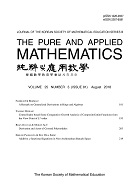 ISSN : 1226-0657
ISSN : 1226-0657
권호 목록
- 2024 (31권)
- 2023 (30권)
- 2022 (29권)
- 2021 (28권)
- 2020 (27권)
- 2019 (26권)
- 2018 (25권)
- 2017 (24권)
- 2016 (23권)
- 2015 (22권)
- 2014 (21권)
- 2013 (20권)
- 2012 (19권)
- 2011 (18권)
- 2010 (17권)
- 2009 (16권)
- 2008 (15권)
- 2007 (14권)
- 2006 (13권)
- 2005 (12권)
- 2004 (11권)
- 2003 (10권)
- 2002 (9권)
- 2001 (8권)
- 2000 (7권)
- 1999 (6권)
- 1998 (5권)
- 1997 (4권)
- 1996 (3권)
- 1995 (2권)
- 1994 (1권)
8권 2호
초록
Abstract
As most Of distributions in applications have a finite support, we introduce the class of finite distributions with the known shape of their central part and the unknown tails. Furthermore, we use the Huber minimax approach to determine the unknown characteristics of this class. We obtain the least informative distributions minimizing Fisher information for location in the classes of the truncated Gaussian and uniform distributions, and these results give the reasonable values of the thresholds of truncation. The properties of the obtained solutions are discussed.
초록
Abstract
In this paper, we define the Mcshane-Stieltjes integral for Banach-valued functions, and will investigate some of its properties and comparison with the Pettis integral.
초록
Abstract
This is a survey article on almost Lorentzian paracontact manifolds. The study of Lorentsian almost paracontact manifolds was initiated by Matsumoto [On Lorentzian paracontact manifolds, Bull. Yamagata Univ. Nat. Sci. 12 (1989), 151-l56]. Later on several authors studied Lorentzian almost paracontact manifolds and their different classes, viz. LP-Sasakian and LSP-Sasakian manifolds. Different types of submanifolds, for example invariant, semi-invariant and almost semi-invariant, of Lorentzian almost paracontact manifold have been studied. Here, we present a brief survey of results on Lorentzian almost paracontact manifolds with their different classes and their different kind of submanifolds.
초록
Abstract
The main object of this paper is to present a transformation formula for a finite series involving <TEX>$_3F_2$</TEX> and some identities associated with the binomial coefficients by making use of the theory of Legendre polynomials <TEX>$P_{n}$</TEX>(x) and some summation theorems for hypergeometric functions <TEX>$_pF_q$</TEX>. Some integral formulas are also considered.
초록
Abstract
In this paper, we study the existence, uniqueness and norm estimate of solutions for the nonlinear delay integro-differential system.
초록
Abstract
Posner [Proc. Amer. Math. Soc. 8 (1957), 1093-1100] defined a derivation on prime rings and Herstein [Canad, Math. Bull. 21 (1978), 369-370] derived commutative property of prime ring with derivations. Recently, Bergen [Canad. Math. Bull. 26 (1983), 267-227], Bell and Daif [Acta. Math. Hunger. 66 (1995), 337-343] studied derivations in primes and semiprime rings. Also, in near-ring theory, Bell and Mason [Near-Rungs and Near-Fields (pp. 31-35), Proceedings of the conference held at the University of Tubingen, 1985. Noth-Holland, Amsterdam, 1987; Math. J. Okayama Univ. 34 (1992), 135-144] and Cho [Pusan Kyongnam Math. J. 12 (1996), no. 1, 63-69] researched derivations in prime and semiprime near-rings. In this paper, Posner, Bell and Mason's results are extended in prime near-rings with some conditions.
초록
Abstract
In this Paper, the notion of <TEX>$\varepsilon$</TEX>-Birkhoff orthogonality introduced by Dragomir [An. Univ. Timisoara Ser. Stiint. Mat. 29(1991), no. 1, 51-58] in normed linear spaces has been extended to metric linear spaces and a decomposition theorem has been proved. Some results of Kainen, Kurkova and Vogt [J. Approx. Theory 105 (2000), no. 2, 252-262] proved on e-near best approximation in normed linear spaces have also been extended to metric linear spaces. It is shown that if (X, d) is a convex metric linear space which is pseudo strictly convex and M a boundedly compact closed subset of X such that for each <TEX>$\varepsilon$</TEX>>0 there exists a continuous <TEX>$\varepsilon$</TEX>-near best approximation <TEX>$\phi$</TEX> : X → M of X by M then M is a chebyshev set .
초록
Abstract
In this paper we modify two indicators related to the global avalanche criterion (GAC) and discuss their properties. Also, we apply the modified indicators to measure the GAC of S-boxes of DES.
초록
Abstract
A k-hypertournament is a complete k-hypergraph with all k-edges endowed with orientations, i.e., orderings of the vertices in the edges. The incidence matrix associated with a k-hypertournament is called a 7-hypertournament matrix, where each row stands for a vertex of the hypertournament. Some properties of the hypertournament matrices are investigated. The sequences of the numbers of 1's and -1's of rows of a k-hypertournament matrix are respectively called the score sequence (resp. losing score sequence) of the matrix and so of the corresponding hypertournament. A necessary and sufficient condition for a sequence to be the score sequence (resp. the losing score sequence) of a k-hypertournament is proved.
